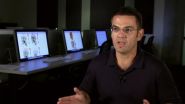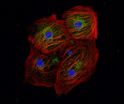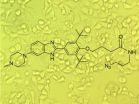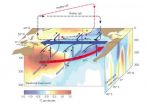(Press-News.org) An 18-month pilot program that brought resources and counselors to elderly Baltimore residents with dementia and other memory disorders significantly increased the length of time they lived successfully at home, according to Johns Hopkins researchers. Staying at home was a clear preference for most of those who participated in the study.
"The project demonstrated that we were able to help such people age in place without sacrificing their quality of life," says study leader Quincy Miles Samus, Ph.D., an assistant professor of psychiatry and behavioral sciences at the Johns Hopkins University School of Medicine.
The trial, known as Maximizing Independence (MIND) at Home, involved 303 people 70 years and older with memory disorders, primarily dementia and mild cognitive impairment. One hundred and ten of them received an in-home visit from a memory care coordinator and nurse that assessed a range of care needs including diagnosis of memory problems, review of medications, behavior problems, daily activities, and untreated medical problems such as hearing or vision problems, and high blood pressure or diabetes. The care team then developed a personalized care plan and worked with the family over time to oversee progress and attend to new needs that arose.
The goal was to see if a dementia care coordination model that incorporated evidence-supported care practices could delay or prevent the need to move from home to other settings like nursing homes or assisted living facilities.
In a report published online last week in The American Journal of Geriatric Psychology, the Johns Hopkins investigators say that those who got 18 months of care coordination with home visits were able to safely stay in their homes a median of 288 extra days, or around 9.5 months over a median follow-up period of about 2 years. "This can make a huge difference in terms of comfort, money and quality of life for those involved," says Samus.
The researchers found that participants who met regularly with coordinators were significantly less likely to leave their homes or die than those in the control group (30 percent versus 45.6 percent). Also, they had fewer unmet care needs, particularly for safety and legal/advance care issues, and had improved quality of life. People with dementia, a growing segment of the population, not only suffer from memory impairment but also have difficulty with daily living tasks and with the ability to safely care for themselves or manage other health issues. Because insurance does not always cover non-medical needs and coordinator services, Samus says her team's research was designed to begin answering the question of whether care models like MIND can demonstrate the financial savings and value of community-based care in hopes that more health insurers might cover the cost programs like this in the future. In the trial, coordinators checked for home safety, nutrition and food availability and whether patients participated in meaningful or purposeful activities beyond simply watching television for much of the day. They also assessed whether patients should be evaluated for driving safety, whether they were at risk of wandering off and getting lost, and what local community resources were available to address unmet needs.
Beyond such services, the program provided education about dementia and memory problems to caregivers and patients, as well as informal counseling and problem-solving. Legal issues such as advance directives and wills were also discussed, and coordinators contacted family members at least once a month. Home and personal safety issues affected 90 percent of the participants at the start of the trial, the researchers report. Some 65 percent needed general medical care, 52 percent showed a lack of meaningful activities and 48 percent needed legal/advance care planning.
The memory care coordinators were community workers and did not have clinical backgrounds or prior training in caring for people with memory disorders, suggesting that the potential workforce that could acquire coordinator skills is large, Samus says. Coordinators received intensive training over 4 weeks, including lectures, role play, and observation of dementia patients in clinical settings.
The care coordinators received hands-on support from a nurse and a physician and the team met weekly to discuss cases.
The results suggest wider application of the home care model should be evaluated in the future as well as whether it can provide a cost-benefit to public insurers like Medicaid and Medicare, says Samus.
INFORMATION:
The study was funded by grants from THE ASSOCIATED: Jewish Community Federation of Baltimore, LeRoy Hoffberger, The Harry and Jeannette Weinberg Foundation, The Hoffberger Foundation, The Hoffberger Family Fund, the Leonard and Helen R. Stulman Charitable Foundation, the David and Barbara B. Hirschhorn Foundation, the Lois and Irving Blum Foundation, Leonor and Marc Blum, the Joseph and Harvey Meyerhoff Family Charitable Funds, The Henry and Ruth Blaustein Rosenberg Foundation, the Baltimore County Department of Aging, Lois Blum Feinblatt, the National Institute of Mental Health and the National Institute on Aging.
Constantine G. Lyketsos, M.D., M.H.S., director of the Department of Psychiatry at Johns Hopkins Bayview Medical Center and the Elizabeth Plank Althouse Professor for Alzheimer's Research, is the study's senior investigator. Deirdre Johnston, M.R.C.Psych, assistant professor of psychiatry and behavioral sciences at the Johns Hopkins University School of Medicine, was the intervention team leader.
Other Johns Hopkins researchers involved in the research include B.S. Black, Ph.D.; E. Hess, M.S.; C. Lyman, B.A.; A. Vavilikolanu, B.S.; J. Pollutra, R.N.; J.M. Leoutsakos, Ph.D.; L.N. Gitlin, Ph.D.; and P.V. Rabins, M.D., M.P.H.
For more information:
http://www.hopkinsmedicine.org/psychiatry/expert_team/faculty/S/Samus.html
Johns Hopkins Medicine (JHM), headquartered in Baltimore, Maryland, is a $6.7 billion integrated global health enterprise and one of the leading health care systems in the United States. JHM unites physicians and scientists of the Johns Hopkins University School of Medicine with the organizations, health professionals and facilities of The Johns Hopkins Hospital and Health System. JHM's vision, "Together, we will deliver the promise of medicine," is supported by its mission to improve the health of the community and the world by setting the standard of excellence in medical education, research and clinical care. Diverse and inclusive, JHM educates medical students, scientists, health care professionals and the public; conducts biomedical research; and provides patient-centered medicine to prevent, diagnose and treat human illness. JHM operates six academic and community hospitals, four suburban health care and surgery centers, and more than 30 primary health care outpatient sites. The Johns Hopkins Hospital, opened in 1889, was ranked number one in the nation for 21 years in a row by U.S. News & World Report.
Click on the link below to unsubscribe
mailto:sympa@lists.johnshopkins.edu?subject=unsubscribe%20jhu_science_and_medicine_news&body=PLEASE%20SEND%20THIS%20EMAIL%20OUT%20FOR%20UNSUBSCRIBIN
Please follow the instructions below if the above link does not work:
Compose an email to: sympa@lists.johnshopkins.edu with Subject: unsubscribe jhu_science_and_medicine_news
* Note: 'unsubscribe jhu_science_and_medicine_news' should be on the SUBJECT line, NOT IN THE MESSAGE BODY.
To contact the list owner mailto:jhu_science_and_medicine_news-request@lists.johnshopkins.edu
Media Contacts:
Lauren Nelson
410-955-8725; lnelso35@jhmi.edu
Stephanie Desmon
410-955-8665; sdesmon1@jhmi.edu END
Experimental care program keeps people with dementia at home longer, study shows
2014-02-10
ELSE PRESS RELEASES FROM THIS DATE:
Research reveals the give and take of urban temperature mitigating technologies
2014-02-10
TEMPE, Ariz. – Life in a warming world is going to require human ingenuity to adapt to the new realities of Earth. Greenhouse-gas induced warming and megapolitan expansion are both significant drivers of our warming planet. Researchers are now assessing adaptation technologies that could help us acclimate to these changing realities.
But how well these adaptation technologies – such as cool roofs, green roofs and hybrids of the two – perform year round and how this performance varies with place remains uncertain.
Now a team of researchers, led by Matei Georgescu, ...
The genetic origins of high-altitude adaptations in Tibetans
2014-02-10
Genetic adaptations for life at high elevations found in residents of the Tibetan plateau likely originated around 30,000 years ago in peoples related to contemporary Sherpa. These genes were passed on to more recent migrants from lower elevations via population mixing, and then amplified by natural selection in the modern Tibetan gene pool, according to a new study by scientists from the University of Chicago and Case Western Reserve University, published in Nature Communications on Feb. 10.
The transfer of beneficial mutations between human populations and selective ...
Study involving twin sisters provides clues for battling aggressive cancers
2014-02-10
CINCINNATI – Analyzing the genomes of twin 3-year-old sisters – one healthy and one with aggressive leukemia – led an international team of researchers to identify a novel molecular target that could become a way to treat recurring and deadly malignancies.
Scientists in China and the United States report their findings online Feb. 9 in Nature Genetics. The study points to a molecular pathway involving a gene called SETD2, which can mutate in blood cells during a critical step as DNA is being transcribed and replicated.
The findings stem from the uniquely rare opportunity ...
Genome editing goes hi-fi
2014-02-10
SAN FRANCISCO, CA—February 9, 2014—Sometimes biology is cruel. Sometimes simply a one-letter change in the human genetic code is the difference between health and a deadly disease. But even though doctors and scientists have long studied disorders caused by these tiny changes, replicating them to study in human stem cells has proven challenging. But now, scientists at the Gladstone Institutes have found a way to efficiently edit the human genome one letter at a time—not only boosting researchers' ability to model human disease, but also paving the way for therapies that ...
Cochlear implants -- with no exterior hardware
2014-02-10
Cochlear implants — medical devices that electrically stimulate the auditory nerve — have granted at least limited hearing to hundreds of thousands of people worldwide who otherwise would be totally deaf. Existing versions of the device, however, require that a disk-shaped transmitter about an inch in diameter be affixed to the skull, with a wire snaking down to a joint microphone and power source that looks like an oversized hearing aid around the patient's ear.
Researchers at MIT's Microsystems Technology Laboratory (MTL), together with physicians from Harvard Medical ...
Scientists invent advanced approach to identify new drug candidates from genome sequence
2014-02-10
JUPITER, FL—February 9, 2014—In research that could ultimately lead to many new medicines, scientists from the Florida campus of The Scripps Research Institute (TSRI) have developed a potentially general approach to design drugs from genome sequence. As a proof of principle, they identified a highly potent compound that causes cancer cells to attack themselves and die.
"This is the first time therapeutic small molecules have been rationally designed from only an RNA sequence—something many doubted could be done," said Matthew Disney, PhD, an associate professor at TSRI ...
Fight or flight? Vocal cues help deer decide during mating season
2014-02-10
Previous studies have shown that male fallow deer, known as bucks, can call for a mate more than 3000 times per hour during the rut (peak of the mating season), and their efforts in calling, fighting and mating can leave them sounding hoarse.
In this new study, published today (10 February) in the journal Behavioral Ecology, scientists were able to gauge that fallow bucks listen to the sound quality of rival males' calls and evaluate how exhausted the caller is and whether they should fight or keep their distance.
"Fallow bucks are among the most impressive vocal athletes ...
Pacific trade winds stall global surface warming -- for now
2014-02-10
Heat stored in the western Pacific Ocean caused by an unprecedented strengthening of the equatorial trade winds appears to be largely responsible for the hiatus in surface warming observed over the past 13 years.
New research published today in the journal Nature Climate Change indicates that the dramatic acceleration in winds has invigorated the circulation of the Pacific Ocean, causing more heat to be taken out of the atmosphere and transferred into the subsurface ocean, while bringing cooler waters to the surface.
"Scientists have long suspected that extra ocean ...
Seven new genetic regions linked to type 2 diabetes
2014-02-10
Seven new genetic regions associated with type 2 diabetes have been identified in the largest study to date of the genetic basis of the disease.
DNA data was brought together from more than 48,000 patients and 139,000 healthy controls from four different ethnic groups. The research was conducted by an international consortium of investigators from 20 countries on four continents, co-led by investigators from Oxford University's Wellcome Trust Centre for Human Genetics.
The majority of such 'genome-wide association studies' have been done in populations with European ...
Optogenetic toolkit goes multicolor
2014-02-10
CAMBRIDGE, MA -- Optogenetics is a technique that allows scientists to control neurons' electrical activity with light by engineering them to express light-sensitive proteins. Within the past decade, it has become a very powerful tool for discovering the functions of different types of cells in the brain.
Most of these light-sensitive proteins, known as opsins, respond to light in the blue-green range. Now, a team led by MIT has discovered an opsin that is sensitive to red light, which allows researchers to independently control the activity of two populations of neurons ...





